Deforestation in Brazil
Brazil once had the highest deforestation rate in the world and in 2005 still had the largest area of forest removed annually.[1] Since 1970, over 700,000 square kilometres (270,000 sq mi) of the Amazon rainforest have been destroyed. In 2012, the Amazon was approximately 5,400,000 square kilometres (2,100,000 sq mi), which is only 87% of the Amazon's original size.[2]

Rainforests have decreased in size primarily due to deforestation. Despite reductions in the deforestation rate over the last ten years, the Amazon rainforest will be reduced by 40% by 2030 at the current rate.[3] Between May 2000 and August 2006, Brazil lost nearly 150,000 square kilometres (58,000 sq mi) of forest, an area larger than Greece. According to the Living Planet Report 2010, deforestation continues at an alarming rate. At the Convention on Biological Diversity's 9th Conference, 67 ministers signed up to help achieve zero net deforestation by 2020.[4]
History
In the 1940s Brazil began a program of national development in the Amazon Basin. President Getúlio Vargas declared emphatically that:
The Amazon, in the impact of our will and labor, will cease to be a simple chapter in the world, and made equivalent to other great rivers, shall become a chapter in the history of human civilization. Everything which has up to now been done in Amazonas, whether in agriculture or extractive industry... must be transformed into rational exploitation.
— Getúlio Vargas[5]
Before the 1960s, much of the forest remained intact due to restrictions on access to the Amazon beyond partial clearing along the river banks.[6] The poor soil made plantation-based agriculture unprofitable. The key point in deforestation of the Amazon came when colonists established farms in the forest in the 1960s. They farmed based on crop cultivation and used the slash and burn method. The colonists were unable to successfully manage their fields and the crops due to weed invasion and loss of soil fertility.[7] Soils in the Amazon are productive for only a very short period of time after the land is cleared, so farmers there must constantly move and clear more and more land.[7]
Amazonian colonization was dominated by cattle raising, not only because grass did grow in the poor soil, but also because ranching required little labor, generated decent profit, and awarded social status. However, farming led to extensive deforestation and environmental damage.[8]
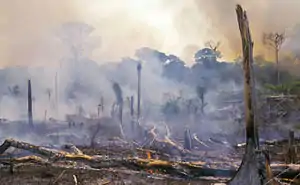
An estimated 30% of deforestation is due to small farmers; the rate of deforestation in areas they inhabit is greater than in areas occupied by medium and large ranchers, who own 89% of the Legal Amazon's private land. This underlines the importance of using previously-cleared land for agriculture, rather than the usual, politically easier path of distributing still-forested areas.[9] The number of small farmers versus large landholders fluctuates with economic and demographic pressures.[9][10][11][12]
Causes

Cattle ranching and infrastructure
The annual rate of deforestation in the Amazon region continued to increase from 1990 to 2003 because of factors at local, national, and international levels.[6] Seventy per cent of formerly forested land in the Amazon, and 91% of land deforested since 1970, is used for livestock pasture.[13][14] The Brazilian government initially attributed 38% of all forest loss between 1966 and 1975 to large-scale cattle ranching. According to the Center for International Forestry Research (CIFOR), "between 1990 and 2001 the percentage of Europe's processed meat imports that came from Brazil rose from 40 to 74 percent" and by 2003 "for the first time ever, the growth in Brazilian cattle production, 80 percent of which was in the Amazon[,] was largely export driven."[15]
Forest removal to make way for cattle ranching was the leading cause of deforestation in the Brazilian Amazon from the mid-1960s on. In addition to Vargas's earlier goal of commercial development, the devaluation of the Brazilian real against the dollar had the result of doubling the price of beef in reals; this gave ranchers a widespread incentive to increase the size of their cattle ranches and areas under pasture for mass beef production, resulting in large areas of forest removal.[16]
Removal of forest cover for cattle farming in Brazil was also seen by developers as an economic investment during periods of high inflation, when appreciation of cattle prices provided a way to outpace the interest earned on money left in the bank. Brazilian beef was more competitive on the world market at a time when extensive improvements in the road network in the Amazonas (such as the introduction of the Trans-Amazonian Highway in the early 1970s) gave potential developers access to vast areas of previously inaccessible forest. This coincided with lower transportation costs due to cheaper fuels such as ethanol, which lowered the costs of shipping the beef and further incentivized the development of remote forested areas.
Cattle ranching is not an environmentally friendly investment though. Cattle emit large amounts of methane. These emissions play a major role in climate change because methane's ability to trap heat is 20 times greater than that of carbon dioxide in a time horizon of 100 years and exponentially higher in shorter time horizons.[17][18] One cow can emit up to 130 gallons of methane a day, just by belching.[19]
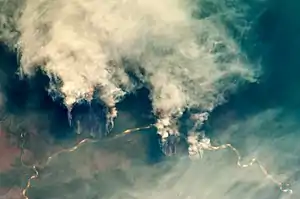
The Brazilian government granted land to approximately 150,000 families in the Amazon between 1995 and 1998. Poor farmers were also encouraged by the government through programmes such as the National Institute for Colonization and Agrarian Reform in Brazil (INCRA) to farm unclaimed forest land and after a five-year period were given a title and the right to sell the land. The productivity of the soil following forest removal for farming lasts only a year or two before the fields become infertile and farmers must clear new areas of forest to maintain their income. In 1995, nearly half (48%) of the deforestation in Brazil was attributed to poorer farmers clearing lots under 125 acres (0.51 km2) in size.
Mining activities
Mining has also increased deforestation in the Brazilian Amazon, particularly since the 1980s, with miners often clearing forest to open the mines or to provide building material, collecting wood for fuel and subsistence agriculture. In February 2017, the Brazilian government provided a reservation with a surface of 46,000 square miles (120,000 km2) for deforestation. The purpose of deforesting this area was to attract foreign investors for more mining activities. However, in September 2017, the government withdrew their permission.
Soybean production
_28mar09.jpg.webp)
Brazil is currently the second-largest global producer of soybeans after the United States, mostly for livestock feed. As prices for soybeans have risen, soy farmers have pushed north into the forested areas of the Amazon. As stated in the Constitution of Brazil, clearing land for crops or fields is considered an "effective use" of land and is the first step toward land ownership.[6] Cleared property is also valued 5–10 times more than forested land, and for that reason is valuable to the owner whose ultimate objective is resale.[6] The soy industry is an important exporter for Brazil;[20][21] therefore, the needs of soy farmers have been used to validate many of the controversial transportation projects being developed in the Amazon.[6]
Cargill, a multinational company which controls the majority of the soya bean trade in Brazil, has been criticized, along with fast food chains like McDonald's, by Greenpeace for accelerating the deforestation of the Amazon. Cargill is the main supplier of soya beans to large fast food companies such as McDonald's which use the soy products to feed their cattle and chickens. As fast-food chains expand, the chains must increase the quantity of their livestock in order to produce more products. In order to meet the resulting demand for soya, Cargill has expanded its soy production by clear-cutting parts of the Amazon.[22]
A report by Greenpeace mentions that European supermarket giant Tesco told Greenpeace that 99% of its soya footprint is made up of animal feed. This is responsible for more than 500,000 tonnes of soya imports into the UK each year, making up more than a sixth of the total.[23]
The same report by Greenpeace also mentions that animal feed for meat production is Europe's largest contribution to deforestation, with soya imports representing 47% of Europe’s deforestation footprint, compared to 14% for pasture expansion for livestock and 10% for palm oil.[24][25]
In 2020, the Amsterdam Declarations Partnership (which includes Germany, France, Denmark, Italy, Norway, the UK and the Netherlands) sent an open letter to vice president Hamilton Mourão, stating that Brazil's backwards moves in environmental protection were threatening Europe’s desire to source its food sustainably.[26]
The first two highways, the Rodovia Belém-Brasília (1958) and the Cuiabá-Porto Velho (1968), were the only federal highways in the Legal Amazon to be paved and passable year-round before the late 1990s. These two highways are said to be "at the heart of the ‘arc of deforestation’" that is the epicenter of deforestation in the Brazilian Amazon. The Belém-Brasília Highway attracted nearly two million settlers in its first twenty years. The success of the Belém-Brasília highway in opening up the forest was re-enacted as paved roads continued to be developed, unleashing the irrepressible spread of settlement. The completion of the roads were followed by a wave of resettlement and the settlers had a significant effect on the forest.[8]
Scientists using NASA satellite data have found that clearing for mechanized cropland has recently become a significant force in Brazilian Amazon deforestation. This change in land use may alter the region's climate and the land's ability to absorb carbon dioxide. Researchers found that in 2003, the peak year of deforestation, more than 20 percent of the Mato Grosso state's forests were converted to cropland. This finding suggests that the recent cropland expansion in the region is contributing to further deforestation. In 2005, soybean prices fell by more than 25 percent and some areas of Mato Grosso showed a decrease in large deforestation events, although the central agricultural zone continued to clear forests. But, deforestation rates could return to the high levels seen in 2003 as soybean and other crop prices begin to rebound in international markets. Brazil has become a leading worldwide producer of grains including soybean, which accounts for 5% of the nation's exports.[27] This new driver of forest loss suggests that the rise and fall of prices for other crops, beef and timber may also have a significant impact on future land use in the region, according to the study.[28]
Logging
.jpg.webp)
Logging in Brazil's Amazon is economically motivated. The economic opportunity for developing regions is driven by timber export and demand for charcoal. Charcoal-producing ovens use large amounts of timber. In one month, the Brazilian government destroyed 800 illegal ovens in Tailândia. These 800 ovens were estimated to consume about 23,000 trees per month.[29] Logging for timber export is selective, since only a few species, such as mahogany, have commercial value and are harvested. Selective logging still does a lot of damage to the forest. For every tree harvested, 5-10 other trees are logged, to transport the logs through the forest. Also, a falling tree takes down a lot of other small trees. A logged forest contains significantly fewer species than areas where selective logging has not taken place. A forest disturbed by selective logging is also significantly more vulnerable to fire.[30]
Logging in the Amazon, in theory, is controlled and only strictly licensed individuals are allowed to harvest the trees in selected areas. In practice, illegal logging is widespread in Brazil.[31][32] Up to 60 to 80 percent of all logging in Brazil is estimated to be illegal, with 70% of the timber cut wasted in the mills.[33] Most illegal logging companies are international companies that don't replant the trees and the practice is extensive. Expensive wood such as mahogany is illegally exported to profit these companies. Fewer trees mean that less photosynthesis will occur and therefore oxygen levels drop. Carbon dioxide emissions increase, as this gas is released from a tree when it's cut down and burned or left to rot. A tree can absorb as much as 48 pounds of carbon per year so illegal logging has a major impact on climate change.[34]
To combat this destruction, the Brazilian government has stopped issuing new permits for logging. Unauthorized harvesting has continued nonetheless. Efforts to prevent cutting down forests include payments to landowners. Instead of banning logging altogether, the government hopes payments of comparable sums will dissuade owners from further deforestation.[35]
COVID-19
The COVID-19 pandemic has increased deforestation in Brazil. The government has been preoccupied by the global pandemic, and unchecked illegal activity has taken place. “The trend line is shooting upward compared to a year that was already historic in terms of a rise in deforestation,” said federal prosecutor Ana Carolina Haliuc Bragança.“If state entities don’t adopt very decisive measures, we’re looking at a likely tragedy.”[36]
Effects

Deforestation and loss of biodiversity have led to high risks of irreversible changes to the Amazon's tropical forests. It has been suggested by modeling studies that the deforestation may be approaching a "tipping point", after which large-scale "savannization" or desertification of the Amazon will take place, with catastrophic consequences for the world's climate, due to a self-perpetuating collapse of the region's biodiversity and ecosystems.[38] In 2018, about 17% of the Amazon rainforest was already destroyed. Research suggests that upon reaching about 20–25%, the tipping point to flip it into a non-forest ecosystems (in eastern, southern and central Amazonia) could be reached.[39][40]
The result of passing the tipping point will be catastrophic for both and will hurt global food security. Carlos Nobres a climate scientist say: “Brazil should be battling the most [to protect the Amazon], because it has the most to lose,”. Experts note that avoiding deforestation and climate change is a top interest of the agricultural sector.[41]
Climate change
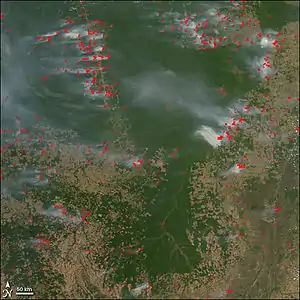
Between July and October 1987, about 19,300 square miles (50,000 km2) of rainforest was burned in the states of Pará, Mato Grosso, Rondônia, and Acre releasing more than 500 million tons of carbon, 44 million tons of carbon monoxide, and millions of tons of nitrogen oxides and other poisonous chemicals into the atmosphere.[42]
Carbon present in the trees is essential for ecosystem development and plays a key role in the regional and global climate. Fallen leaves from deforestation leave behind a mass of dead plant material known as slash, which on decomposition provides a food source for invertebrates. This has the indirect effect of increasing atmospheric carbon dioxide levels through respiration and microbial activity.[43] Simultaneously the organic carbon in the soil structure becomes depleted; the presence of carbon plays a vital role in the functioning of life in any ecosystem.
Biodiversity
Rainforests are the oldest ecosystems on earth. Rainforest plants and animals continue to evolve, developing into the most diverse and complex ecosystems on earth. Living in limited areas, most of these species are endemic, found nowhere else in the world. In tropical rainforests, an estimated 90% of the species of the ecosystem live in the canopy. Since tropical rainforests are estimated to hold 50% of the planet's species, the canopy of rainforests worldwide may hold 45% of life on Earth. The Amazon rainforest borders eight countries, and has the world's largest river basin and is the source of 1/5 of the Earth's river water. It has the world's greatest diversity of birds and freshwater fish. The Amazon is home to more species of plants and animals than any other terrestrial ecosystem on the planet—perhaps 30% of the world's species are found there.
More than 300 species of mammals are found in the Amazon, the majority of them bats and rodents. The Amazon basin contains more freshwater fish species than anywhere else in the world—more than 3,000 species. More than 1,500 bird species are also found there. Frogs are overwhelmingly the most abundant amphibians in the rainforest. Species interdependence takes many forms in the forest, from species relying on other species for pollination and seed dispersal to predator-prey relationships and symbiotic relationships. Each species that disappears from the ecosystem may weaken the survival chances of another, while the loss of a keystone species—an organism that links many other species together—could cause a significant disruption in the functioning of the entire system.
.jpg.webp)
Indigenous people
A WRI report mentions that “tenure-secure” indigenous lands generates billions and sometimes trillions of dollars’ worth of benefits in the form of carbon sequestration, reduced pollution, clean water and more. It says that tenure-secure indigenous lands have low deforestation rates,[44][45] they help to reduce GHG emissions, control erosion and flooding by anchoring soil, and provide a suite of other local, regional and global “ecosystem services.” However, many of these communities find themselves on the front lines of the deforestation crisis, and their lives and livelihoods threatened.[46][47][48]
On March 30th, 2020, land defender Zezico Guajajara's body was found near his village. Zezico was a member of the protected Guajajara Tribe in the Amazon who started the Guardians of the Forest in 2012. [49]
Land degradation
Deforestation for the export of timber removes valuable protection for the soils in a dynamic ecosystem; thus regions are prone to desertification and silting of river banks as rivers become clogged with eroded soils in sparse areas. If too much timber is cut, soil that once had sufficient cover can get baked and dry out in the sun, leading to erosion and degradation of soil fertility; this means farmers cannot profit from their land even after clearing it. According to the United Nations Environmental Programme (UNEP) in 1977, deforestation is a major cause of desertification and in 1980 threatened 35% of the world's land surface and 20% of the world's population.
Pollution
Exploitation of forests for mining activities such as gold mining has also significantly increased the risk of mercury poisoning and contamination of the ecosystem and water.[50] Mercury poisoning can affect the food chain and affect wildlife both on land and in the rivers. It can also affect plants and the crops of farmers trying to farm forest areas. Pollution may result from mine sludge and affect the functioning of the river system when exposed soil is blown in the wind and can have a significant impact on aquatic populations further affected by dam building in the region. Dams may have a profound impact on migrating fish and ecological life and leave plains prone to flooding and leaching.
In August 2019, smoke from wildfires in Brazil's rainforests became so thick that it arrived in São Paulo and plunged the city into darkness in the middle of the day for an hour, prompting the spread of the hashtag "prayforamazonia" on social media.[51]
Water supply
The deforestation of the Amazon has already had a significant negative impact on Brazil's freshwater supply, harming, among others, the agricultural industry that has contributed to the clearing of the forests. In 2005, parts of the Amazon basin experienced the worst drought in more than a century.[52] This has been the result of two factors:
- The rainforest provides much of the rainfall in Brazil, even in areas far from it. Deforestation increased the impacts of the droughts of 2005, 2010, and 2015–2016.[53][54]
- The rainforest, by inducing rainfall and helping with water storage, provides freshwater to the rivers that give water to Brazil and other countries.[55][56]
Even modest increases in Amazon forest loss may reduce water supplies in Brazilian cities and in neighboring countries. More massive deforestation could alter water supplies as far away as Africa or California.[54][53]
As of 2020 deforestation in Brazil is close to reach a tipping point after which the forest will change to savanna. The result of passing such tipping point will be catastrophic for the agriculture and hydroelectricity in Brazil. Already both sectors are severely hurt. For example, the rainy season has been shortened by 15 - 30 days in 40 years, the amount of rainfall decreased, the harvest became lower in many areas, the mega dam Belo Monte can produce less power. In the future, the soya sector can lose 40% of productivity even in areas with low risk, the hydroelectric sector more than 80%. The lack of water can cause water conflict between the different sectors of the economy. Also passing the tipping point will hurt global food security.
Carlos Nobre, a climate scientist says: “Brazil should be battling the most [to protect the Amazon] because it has the most to lose.” Experts note that avoiding deforestation and climate change is a top interest of the agricultural sector because it existence depending on it.[57]
Impact on local temperature
In 2019, a group of scientists published research suggesting that in a "business as usual" scenario, the deforestation of the Amazon Rainforest would raise the temperature in Brazil by 1.45 degrees. They wrote: "Increased temperatures in already hot locations may increase human mortality rates and electricity demands, reduce agricultural yields and water resources, and contribute to biodiversity collapse, particularly in tropical regions. Furthermore, local warming may cause shifts in species distributions, including for species involved in infectious disease transmissions." The authors of the paper say that deforestation is already causing a rise in the temperature.[58]
NASA survey


In the American Meteorological Society Journal of Climate, two research meteorologists at NASA's Goddard Space Flight Center, Andrew Negri and Robert Adler, have analysed the impact of deforestation on climatic patterns in the Amazon using data and observatory readings collected from NASA's Tropical Rainfall Measuring Mission over many years. Working with the University of Arizona and the North Carolina State University, Negri said, "In deforested areas, the land heats up faster and reaches a higher temperature, leading to localized upward motions that enhance the formation of clouds and ultimately produce more rainfall".[59]
They also examined cloud cover in deforested areas. In comparison with areas still unaffected by deforestation, they found a significant increase in cloud cover and rainfall during the August–September wet season where the forest had been cleared. The height or existence of plants and trees in the forest directly affects the aerodynamics of the atmosphere, and precipitation in the area. In addition, the Massachusetts Institute of Technology developed a series of detailed computer simulation models of rainfall patterns in the Amazon during the 1990s and concluded that forest removal also leaves soil exposed to the sun, and the increased temperature on the surface enhances evaporation and increases moisture in the air.
Measured rates
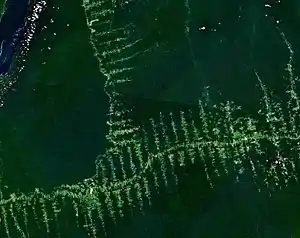
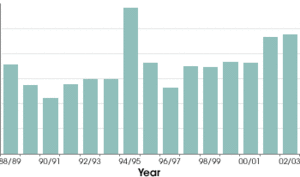
Deforestation rates in the Brazilian Amazon have slowed dramatically since peaking in 2004 at 27,423 square kilometers per year. By 2009, deforestation had fallen to around 7,000 square kilometers per year, a decline of nearly 75 percent from 2004, according to Brazil's National Institute for Space Research (Instituto Nacional de Pesquisas Espaciais, or INPE),[60] which produces deforestation figures annually.
Their deforestation estimates are derived from 100 to 220 images taken during the dry season in the Amazon by the China–Brazil Earth Resources Satellite program (CBS), and may only consider the loss of the Amazon rainforest – not the loss of natural fields or savanna within the Amazon biome. According to INPE, the original Amazon rainforest biome in Brazil of 4,100,000 km2 was reduced to 3,403,000 km2 by 2005 – representing a loss of 17.1%.[60]
In 2018, Brazil released its worst annual deforestation figures in a decade amid fears that the situation might worsen when the avowedly anti-environmentalist president-elect Jair Bolsonaro took power. Between August 2017 and July 2018, 7,900 km2 were deforested, according to preliminary figures from the environment ministry based on satellite monitoring – a 13.7% rise from the previous year and the biggest area of forest cleared since 2008. The area is equivalent to 987,000 football pitches.[61][62] Deforestation in the Brazilian Amazon rose more than 88% in June 2019 compared with the same month in 2018.[63] In the year 2019 approximately 9,762 square kilometers of the Amazonian forest were destroyed, 30% more than in the previous year. Environmental groups, scientists accused the policy of the government of Bolsonaro that rejected the blames.[64] In January 2020, deforestation more than doubled compared with the previous year.[65]
Estimates of the rates of deforestation in the Amazon rainforest from 1970 thru 2017 are given in the table below, based on data from the National Institute for Space Research and the Food and Agriculture Organization (FAO).[66]
| Period | Estimated remaining forest cover in the Brazilian Amazon (km2) | Annual forest loss (km2) | Percent of 1970 cover remaining | Total forest loss since 1970 (km2) |
|---|---|---|---|---|
| Pre–1970 | 4,100,000 | — | — | — |
| 1977 | 3,955,870 | 21,130 | 96.5% | 144,130 |
| 1978–1987 | 3,744,570 | 21,130 | 91.3% | 355,430 |
| 1988 | 3,723,520 | 21,050 | 90.8% | 376,480 |
| 1989 | 3,705,750 | 17,770 | 90.4% | 394,250 |
| 1990 | 3,692,020 | 13,730 | 90.0% | 407,980 |
| 1991 | 3,680,990 | 11,030 | 89.8% | 419,010 |
| 1992 | 3,667,204 | 13,786 | 89.4% | 432,796 |
| 1993 | 3,652,308 | 14,896 | 89.1% | 447,692 |
| 1994 | 3,637,412 | 14,896 | 88.7% | 462,588 |
| 1995 | 3,608,353 | 29,059 | 88.0% | 491,647 |
| 1996 | 3,590,192 | 18,161 | 87.6% | 509,808 |
| 1997 | 3,576,965 | 13,227 | 87.2% | 523,035 |
| 1998 | 3,559,582 | 17,383 | 86.8% | 540,418 |
| 1999 | 3,542,323 | 17,259 | 86.4% | 557,677 |
| 2000 | 3,524,097 | 18,226 | 86.0% | 575,903 |
| 2001 | 3,505,932 | 18,165 | 85.5% | 594,068 |
| 2002 | 3,484,281 | 21,651 | 85.0% | 615,719 |
| 2003 | 3,458,885 | 25,396 | 84.4% | 641,115 |
| 2004 | 3,431,113 | 27,772 | 83.7% | 668,887 |
| 2005 | 3,412,099 | 19,014 | 83.2% | 687,901 |
| 2006 | 3,397,814 | 14,285 | 82.9% | 702,186 |
| 2007 | 3,386,163 | 11,651 | 82.6% | 713,837 |
| 2008 | 3,373,252 | 12,911 | 82.3% | 726,748 |
| 2009 | 3,365,788 | 7,464 | 82.1% | 734,212 |
| 2010 | 3,358,788 | 7,000 | 81.9% | 741,212 |
| 2011 | 3,352,370 | 6,418 | 81.8% | 747,630 |
| 2012 | 3,347,799 | 4,571 | 81.7% | 752,201 |
| 2013 | 3,341,908 | 5,891 | 81.5% | 758,092 |
| 2014 | 3,336,896 | 5,012 | 81.4% | 763,104 |
| 2015 | 3,330,689 | 6,207 | 81.2% | 769,311 |
| 2016 | 3,322,796 | 7,893 | 81.0% | 777,204 |
| 2017 | 3,315,849 | 6,947 | 80.9% | 784,151 |
| 2018 | 3,307,949 | 7,900 | 80.7% | 792,051 |

Response
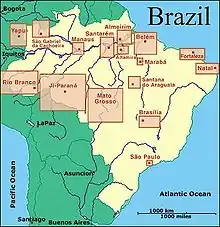
By the end of the 1980s, the removal of Brazil's forests had become a serious global issue, not only because of the loss of biodiversity and ecological disruption, but also because of the large amounts of carbon dioxide (CO2) released from burned forests and the loss of a valuable sink to absorb global CO2 emissions. At the 1992 UN Framework Convention on Climate Change, deforestation became a key issue addressed at the summit in Rio de Janeiro. Plans for the compensated reduction (CR) of greenhouse gas emissions from tropical forests were set up to give nations like Brazil an incentive to curb their rate of deforestation.
"We are encouraging the Brazilian government to fully endorse the Compensated Reduction proposal", said scientist Paulo Moutinho, coordinator of the climate change program of the Amazon Institute for Environmental Research (IPAM), an NGO research institute in Brazil.[68]
On May 11, 1994, NASA scientists, Compton Tucker and David Skole concluded that satellite observations showed a reduction in the rate of forest removal between 1992 and 1993 and that World Bank estimates of 600,000 square km2 (12%) cleared to that point appeared to be too high. The NASA assessment concurred with the findings of the Brazilian National Space Research Institute (INPE) of an estimated 280,000 km2 (5%) in the same period.[69]
The following year (1995) deforestation nearly doubled; this has been attributed to the accidental fire following the El Niño-related drought rather than active logging; the following year again showed a major drop.[70] In 2002, Brazil ratified the Kyoto Agreement as a developing nation listed in the non-Annex I countries. These countries do not have carbon emission quotas in the agreement as developed nations do.[71] President Luiz Inácio Lula da Silva reiterated that Brazil: "is in charge of looking after the Amazon".[72]
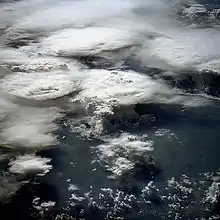
In 2006, Brazil proposed a direct finance project to deal with the Reduced Emissions from Deforestation and Degradation in Developing Countries, or REDD, issue, recognizing that deforestation contributes to 20% of the world's greenhouse gas emissions. The competing proposal for the REDD issue was a carbon emission credit system, where reduced deforestation would receive "marketable emissions credits". In effect, developed countries could reduce their carbon emissions, and approach their emissions quota by investing in the reforestation of developing rainforest countries. Instead, Brazil's 2006 proposal would draw from a fund based on donor country contributors.[72]
By 2005 forest removal had fallen to 9,000 km2 (3,500 sq mi) of forest compared to 18,000 km2 (6,900 sq mi) in 2003[73] and on July 5, 2007, Brazilian president Luiz Inácio Lula da Silva announced at the International Conference on Biofuels in Brussels that more than 20 million hectares of conservation units to protect the forest and more efficient fuel production had allowed the rate of deforestation to fall by 52% in the three years since 2004.[74]
The academic evidence suggests that the creation of public lands, through the assignment of property rights, reduces incentives to deforest land for agricultural conversion and contributes to lower land-related conflict.[75]
In 2005, Brazilian Environment Minister Marina da Silva announced that 9,000 km2 (3,500 sq mi) of forest had been felled in the previous year, compared with more than 18,000 km2 (6,900 sq mi) in 2003 and 2004.[73] Between 2005 and 2006 there was a 41% drop in deforestation; nonetheless, Brazil still had the largest area of forest removed annually on the planet.[1]
These methods have also reduced the illegal appropriation of land and logging, encouraging the use of land for sustainable timber harvesting.
At the end of August 2019 after an international outcry and warning from experts that fires can increase even more, the Brazilian government of Jair Bolsonaro begun to take measures to stop the fires in the Amazon rainforest. The measures include:
- 60 day ban for clearing forest with fires.
- Sending 44,000 soldiers to fight the fires.
- Accepting 4 planes from Chile for battle the fires.
- Accepting 12 million dollars of aid from the United Kingdom government
- Softening his position about aid from the G7.
- Appealing for a Latin America conference to preserve the Amazon[76][77]
The Current State as of 2019 and its Future
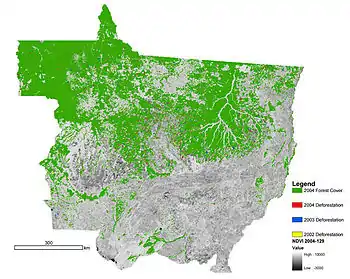
To diminish deforestation in the Brazilian Amazon, some organisations have argued that large financial resources are required to give illegal loggers an economic incentive to pursue other areas of activity. The World Wide Fund for Nature (WWF) estimated in 2007 that a total of approximately US$547.2 million (1 billion Brazilian reais) per year would be required from international sources to compensate the forest developers and establish a highly organized framework to fully implement forest governance and monitoring,[78] and the foundation of new protected forest areas in the Amazon for future sustainability.[79]
Non-governmental organizations (NGOs) such as WWF have been active in the region, and WWF Brazil formed an alliance with eight other Brazilian NGOs who aimed to completely halt deforestation in the Amazon by 2015. However, deforestation continues; in July 2019, the rate reached a four-year high.[80] Deforestation has rapidly increased over 30 percent since 2018 according to the INPE. The Amazon's deforestation has been seen to be at its highest levels since 2008.[81] This could have long-term implications for the health of the region and its significant impact on the functionality of the global ecosystem. Models suggest that the Amazon may be reaching a tipping point due to the deforestation and rising temperatures.[82]
Under Jair Bolsonaro's government, elected to power in January 2019, policies surrounding deforestation have relaxed. Bolsonaro and other senior figures have encouraged the exploitation of the Amazon rainforest, denigrated critics and denied man-made climate change.[83] Some environmental laws have been weakened and there has been a cut in funding and personnel at key government agencies[84] and a firing of the heads of the agency's state bodies.[85]

See also
- 2018 in Brazil
- 2019 Brazil wildfires
- Agriculture in Brazil
- Amazon rainforest § Deforestation
- Carbon Border Adjustment Mechanism
- Coffee plantation
- Coffee production in Brazil
- Deforestation of the Amazon Rainforest
- Environment of Brazil
- Environmental issues in Brazil
- Environmental history of Latin America
- Stern Review's cost estimates of climate change
References
- "World deforestation rates and forest cover statistics, 2000-2005". news.mongabay.com. 2005-11-16. Retrieved 15 April 2018.
- Malhi, Y.; J. Timmons Roberts; Richard A. Betts; Timothy J. Killeen; Wenhong Li; Carlos A. Nobre (2009). "Climate Change, Deforestation, and the Fate of the Amazon". Science. 319 (5860): 169–172. CiteSeerX 10.1.1.389.7410. doi:10.1126/science.1146961. PMID 18048654. S2CID 33966731.
- National Geographic. January 2007.
- "Living Planet Report 2010". 2010. Retrieved 23 September 2013. Cite journal requires
|journal=(help) - Hall, A.L. (1989) Developing Amazonia, Manchester: Manchester University Press.
- Kirby, K. R., Laurance, W. F., Albernaz, A. K., Schroth, G., Fearnside, P. M., Bergen, S., Venticinque, E. M., & De Costa, C. (2006). "The future of deforestation in the Brazilian Amazon". Futures. 38 (4): 432–453. CiteSeerX 10.1.1.574.7212. doi:10.1016/j.futures.2005.07.011. ISSN 0016-3287.CS1 maint: multiple names: authors list (link)
- Watkins and Griffiths, J. (2000). Forest Destruction and Sustainable Agriculture in the Brazilian Amazon: a Literature Review (Doctoral dissertation, The University of Reading, 2000). Dissertation Abstracts International, 15-17
- Williams, M. (2006). Deforesting the Earth: From Prehistory to Global Crisis. Chicago, IL: The University of Chicago Press.
- Fernside, P. M. (2005). "Deforestation in Brazilian Amazonia: History, Rates, and Consequences" (PDF). Conservation Biology. 19 (3): 680–688. doi:10.1111/j.1523-1739.2005.00697.x.
- Crittenden, Elizabeth A. "Brazil Deforestation: Latifundios and Landless". Archived from the original on 30 October 2015. Retrieved 15 April 2018.
- Andrew Buncombe (2005-03-29). "Brazil: Battle for the Heart of the Forest". The Independent UK. Archived from the original on 2006-11-21. Retrieved 2007-12-10.
- "Speeches and Articles - Prince of Wales". www.princeofwales.gov.uk. Retrieved 3 June 2019.
- Steinfeld, Henning; Gerber, Pierre; Wassenaar, T. D.; Castel, Vincent (2006). Livestock's Long Shadow: Environmental Issues and Options. Food and Agriculture Organization of the United Nations. ISBN 978-92-5-105571-7.
- Sergio Margolis. "Causes of Deforestation of the Brazilian Amazon." World Bank Working Paper No. 22. The World Bank. 2004.
- Center for International Forestry Research (2007-10-27). "Beef exports fuel loss of Amazonian Forest". Center for International Forestry Research. Archived from the original on 2007-12-09. Retrieved 2007-11-27.
- "Deforestation in the Amazon." mongabay.com.
- "IPCC Fourth Assessment Report: Climate Change 2007; Climate Change 2007: Working Group I: The Physical Science Basis; 2.10.2 Direct Global Warming Potentials". Intergovernmental Panel on Climate Change. Retrieved September 12, 2016.
- Shindell, D. T.; Faluvegi, G.; Koch, D. M.; Schmidt, G. A.; Unger, N.; Bauer, S. E. (2009), "Improved attribution of climate forcing to emissions", Science (in German) (Science 326 ed.), 326 (5953): 716–718, doi:10.1126/science.1174760, PMID 19900930, S2CID 30881469 Online
- "A Warming World Pollution on the Hoof". Los Angeles Times. 2007-10-15. Retrieved 19 April 2011.
- Cattelan, Alexandre; Dall’Agnol, Amélio. "December 2017". Oilseeds & fats Crops and Lipids. 25 – via EDP Open.
- "Brazil's thriving soy industry threatens its forests and global climate targets". The Conversation. Retrieved 24 November 2020.
- Greenpeace. 2006. We're trashin' it: how McDonald's is eating up the Amazon. Amsterdam: Greenpeace.
- 'Dumping beef for chicken is killing the rainforest' - Greenpeace
- 'Dumping beef for chicken is killing the rainforest' - Greenpeace
- Winging it: how the UK’s chicken habit is fuelling the climate and nature emergency
- Eight European countries are calling for Brazil to act on Amazon deforestation
- Simoes, Alexander. "The Observatory of Economic Complexity - What does Brazil Export". MIT. Archived from the original on 4 February 2014. Retrieved 22 January 2014.
- Bettwy, Mike (19 September 2006). "Growth in Amazon Cropland May Impact Climate and Deforestation Patterns". Greenbelt, Maryland: NASA. Retrieved 27 October 2015. Also available from NASA Earth Observatory News.
- Reel, Monte. "Brazil Crackdown on Loggers After Surge in Cutting." Washington Post. 21 March 2008.
- "Search - The Encyclopedia of Earth". eoearth.org. Retrieved 15 April 2018.
- "Brazil | Illegal Logging Portal". www.illegal-logging.info. Retrieved 2016-05-17.
- "Amazon Destruction". Mongabay.com. Retrieved 2016-05-17.
- "Amazon Rainforest". Greenpeace USA. Retrieved 2016-05-17.
- "Untitled Document". projects.ncsu.edu. Retrieved 15 April 2018.
- Lynch, Patrick. "Concept: Paying People to Not Cut Down Trees." Daily Press, Newport News, VA. 6 Jan. 2008: A1.
- Londoño, Ernesto; Andreoni, Manuela; Casado, Letícia (6 June 2020). "Amazon Deforestation Soars as Pandemic Hobbles Enforcement". The New York Times. Retrieved 27 September 2020.
- Kottasová, Ivana; Pettersson, Henrik; Shveda, Krystina (13 November 2020). "The world's largest wetlands are on fire. That's a disaster for all of us". CNN. Retrieved 19 November 2020.
- A. Nobre, Carlos; Sampaio, Gilvan; Borma, Laura; Carlos Castilla-Rubio, Juan; S. Silva, José; Cardoso, Manoel (September 27, 2016). "Land-use and climate change risks in the Amazon and the need of a novel sustainable development paradigm". Proceedings of the National Academy of Sciences of the United States of America. 113 (39): 10759–10768. doi:10.1073/pnas.1605516113. PMC 5047175. PMID 27638214.
- Lovejoy, Thomas E.; Nobre, Carlos (2018-02-01). "Amazon Tipping Point". Science Advances. 4 (2): eaat2340. doi:10.1126/sciadv.aat2340. ISSN 2375-2548. PMC 5821491. PMID 29492460.
- "Will Deforestation and Warming Push the Amazon to a Tipping Point?". Yale E360. Retrieved 2019-11-28.
- Hanbury, Shanna (24 February 2020). "Amazon Tipping Point puts Brazil's agribusiness, energy sector at risk: Top scientists". Mongabay. Retrieved 12 March 2020.
- "Fires in the Rainforest". Mongabay.com.
- Jason Wolfe, Earth Observatory (2003-01-21). "The Road to Recovery". NASA Earth Observatory. Archived from the original on 2008-05-11. Retrieved 2007-12-03.
- Protecting Indigenous Land Rights Makes Good Economic Sense
- Climate Benefits, Tenure Costs
- Defending the defenders: tropical forests in the front line
- Protect indigenous people’s land rights and the whole world will benefit
- What role do indigenous people and forests have in a sustainable future?
- "Amazon land activist shot dead in Brazil". BBC News. 2020-04-02. Retrieved 2020-04-02.
- "Mercury poisoning disease re-emerges". BBC News. Retrieved 15 April 2018.
- Bramwell, Kris (20 August 2019). "Brazil fires prompt 'prayers' for Amazon rainforest". BBC. Retrieved 22 August 2019.
- "Amazon Drought Worst in 100 Years". ENS Newswire. 24 October 2005. Retrieved 14 May 2019.
- Welch, Craig (19 November 2018). "How Amazon forest loss may affect water—and climate—far away". National Geographic Magazine. Retrieved 19 April 2019.
- Loomis, Ilima (August 4, 2017). "Trees in the Amazon make their own rain". Science. doi:10.1126/science.aan7209. Retrieved 30 April 2019.
- McCarthy, Joe; Sanchez, Erica. "World's Water Could Become Scarce if the Amazon Rainforest Is Destroyed". Global Citizen. Retrieved 19 April 2019.
- Larson, Christina; Savarese, Mauricio. "Scientists warn new Brazil president may smother rainforest". Fhys.org. Science X Network. Retrieved 19 April 2019.
- Hanbury, Shanna (24 February 2020). "Amazon Tipping Point puts Brazil's agribusiness, energy sector at risk: Top scientists". Mongabay. Retrieved 12 March 2020.
- A. Prevedello, Jayme; R. Winck, Gisele; M. Weber, Marcelo; Nichols, Elizabeth; Sinervo, Barry (March 20, 2019). "Impacts of forestation and deforestation on local temperature across the globe". PLOS ONE. 14 (3): e0213368. doi:10.1371/journal.pone.0213368. PMC 6426338. PMID 30893352.
- NASA, Goddard Space Flight Center (June 9, 2004). "NASA data shows deforestation affects climate in the Amazon". Retrieved 2007-12-09.
- National Institute for Space Research (INPE) (2010)
- Phillips, Dom (2018-11-23). "Brazil records worst annual deforestation for a decade". The Guardian. Retrieved 2019-05-14.
- Teixeira, Marcelo (2018-11-27). "Deforestation in the Brazilian Amazon has reached a 10-year high". World Economic Forum. Retrieved 2019-05-14.
- Reuters (2019-07-03). "Brazil: huge rise in Amazon destruction under Bolsonaro, figures show". The Guardian. ISSN 0261-3077. Retrieved 2019-07-03.
- Martyr, Kate (December 16, 2019). "Amazon Sees Alarming Rise in Deforestation". Deutsche Welle. Ecowatch. Retrieved 18 December 2019.
- "Amazon deforestation for January hits record". phys.org. 2020-02-08. Retrieved 2020-02-10.
- "Calculating Deforestation in the Amazon". Mongabay.com. Retrieved 2016-03-08.
- "VASCONCELOS, Vitor Vieira. Map of Deforestation in Brazil for each Biome: 2002 to 2008. Ministério Público de Minas Gerais. Coordenadoria Geral de Promotorias por Bacias Hidrográficas. 2012". Retrieved 15 April 2018.
- Science Daily. Published May 16, 2007. Retrieved November 27, 2007.
- Deforestation - Facts
- "Features". earthobservatory.nasa.gov. 15 April 2018. Retrieved 15 April 2018.
- "Brazilian Senate Ratifies Kyoto Protocol." UN Wire: Email News Covering the United Nations and the World. 24 Jan 2009.
- "Brazil will forge its own path for developing the Amazon." Conservation news and environmental science news. 26 Jan 2009.
- Tony Gibb, BBC News (2006-08-26). "Deforestation of Amazon halved". BBC.co.uk. Retrieved 2007-11-27.
- Embassy of Brazil in London (2007-07-05). "President Luiz Inácio Lula da Silva - International Conference on Biofuels". Brazil.org. Archived from the original on 2010-06-04. Retrieved 2009-12-14.
- Thiemo Fetzer; Samuel Marden (2016-04-12). "Take what you can: property rights, contestability and conflict" (PDF). Economic Journal. Retrieved 2016-06-14.
- Rosane, Olivia (August 30, 2019). "Brazil Announces 60-Day Ban on Clearing Land With Fire". Ecowatch. Retrieved 1 September 2019.
- Darlington, Shasta (August 29, 2019 CNN takes you into heart of the Amazon fires). "Bolsonaro bans land-clearing fires in Amazon for 60 days". CNN. Retrieved 1 September 2019. Check date values in:
|date=(help) - Herro, Alana (13 October 2007). ""Zero" Amazon Deforestation Possible by 2015, Brazilian NGOs say". Worldchanging. Archived from the original on 15 October 2007. Retrieved 9 December 2007.
- Taitson, Bruno (October 4, 2007). "Pact to end deforestation launched in the Amazon". World Wide Fund for Nature. Archived from the original on 9 February 2008. Retrieved 23 August 2019.
- Whiteside, Philip (8 August 2019). "Brazil deforestation at highest rate for four years". Sky News. Sky UK. Retrieved 23 August 2019.
- "Brazil: deforestation in the Amazon increased 29% over last year". Mongabay Environmental News. 2016-11-30. Retrieved 2019-12-03.
- Nobre, Carlos A.; Sampaio, Gilvan; Borma, Laura S.; Castilla-Rubio, Juan Carlos; Silva, José S.; Cardoso, Manoel (2016-09-27). "Land-use and climate change risks in the Amazon and the need of a novel sustainable development paradigm". Proceedings of the National Academy of Sciences. 113 (39): 10759–10768. doi:10.1073/pnas.1605516113. ISSN 0027-8424. PMC 5047175. PMID 27638214.
- Watts, Jonathan (25 July 2019). "Amazon deforestation accelerating towards unrecoverable 'tipping point'". Guardian News & Media Limited. Retrieved 23 August 2019.
- Amazon Deforestation in Brazil Rose Sharply
- Brazil guts environmental agencies, clears way for unchecked deforestation
External links
| Wikimedia Commons has media related to Deforestation. |
- Images of deforestation in the Amazon
- Reversing deforestation in Brazil? an academic article
- Mecanismos y actors Sociales en la deforestación de la Amazonia brasileña
- Phillips, Dom; Wasley, Andrew; Heal, Alexandra (July 2, 2019). "Revealed: rampant deforestation of Amazon driven by global greed for meat". The Guardian.
- Cattle Ranching in the Amazon Region. Yale School of Forestry & Environmental Studies
.svg.png.webp)